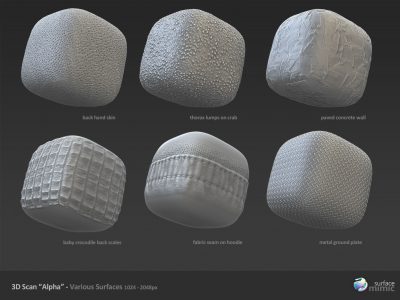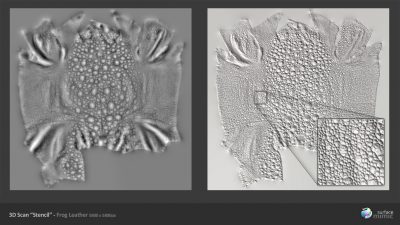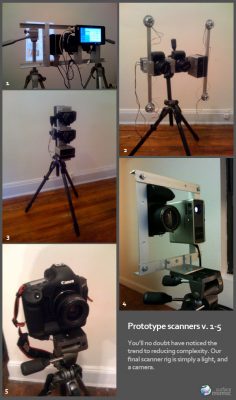There is a clear demand for textile and skin samples, but also for environmental surfaces such as rocks and concrete. Now there is a new site and source of textures striving to be an indispensable tool for digital artists. We speak to www.surfacemimic.com founder Paul Callender about this great new professional site for textures.
fxg: When did you start?
The new site has only been public a little over a week. I started the company about 6 months ago, and the idea and research I’ve been working on for over four years. It’s great to have the scans out there now. Seeing people use them in their professional work is extremely rewarding.

fxg: What resolution are the displacement maps?
I have two displacement scan types, “alphas” and “stencils”. Alphas are ZBrush’s terminology for displacement maps. Mudbox users know them as “stamps”. Surface Mimic alphas tile seamlessly, and range mostly from 1024 to 2048. Stencils are brand new on Surface Mimic and have much greater resolution. They cater specifically for Mari and Mudbox users working on photo-real content where projection painting displacement can save hours of work. Stencils can go anywhere from 2k, up to 6k depending on the subject matter.
fxg: Can you do custom larger scans?
Absolutely. The resolution is only limited by the resolution of the scanning camera, or the ability to stitch several scans together. My existing camera is a 10MP Canon, so most stencils will be around 10-16MP equivalent. 2048×2048 is about the maximum for alphas, but as I upgrade my equipment this will increase. In the future, moving to a medium format digital camera could boost the resolution far higher.
These days I use a fairly simple setup. A camera with tripod, a portable strobe for lighting and an 8ball. The 8ball is used to calibrate the light vector in each photo. I take tens of photos of the same subject varying only the position of the light. My custom code takes care of the rest, resulting in a displacement map.
fxg: Did you build that rig?
I did. My existing setup is nearly entirely off the shelf professional camera gear, but it wasn’t always that way. My first rig used two cameras and a projector with mounted lights controlled by a tablet PC. Over time, I whittled down the unnecessary equipment maximizing flexibility, and minimizing weight. Now I can comfortably travel anywhere on foot to scan remote surfaces.
fxg: What is a working average price for say some skin textures?
I like keeping things simple, so all Alphas are $5. Most stencils will go for $5 or $10, depending on the cost of the subject matter, and the resolution.
fxg: What is your background? I understand it is gaming?
I’ve been working in games since 2000. My last project was as a level designer for Homefront Multiplayer. People seem a little surprised, since level design is so different from 3d scanning. However, level designers usually have a wide skillset to draw on, and my education was in graphic design. I guess I was able to pull together enough art, code and design to make it work.
fxg: What has the response been since you launched?
Much more than I expected. I’ve been pretty busy this last week, and it’s still early days. I think the idea presents itself well to artists without too much explanation. If you’re painting something highly realistic, why can’t you just paint real displacement maps to get that detail? Already I’ve had some pretty happy artists saying they’ve saved hours just projecting detail, with better results to boot. So far, most of the interest is from game companies, because that’s my home turf. I’m now seeing increasing interest in the higher resolution stuff from artists at fx companies, especially face and body scans.

fxg: When you launched, the site mainly mentioned Mudbox and ZBrush…but I assume also Mari?
Correct. Mari became pretty interesting when The Foundry added DX11 realtime displacement. The bulk of the surfaces I scan are bassrelief, and can be used to add photoreal displacement details easily. Mudbox sits somewhere between Mari and ZBrush, with excellent projection painting tools. ZBrush is the game industry staple for modelling high resolution character and monster models. I’ll also throw in a mention for 3D-Coat. It’s highly innovative and had some great features, such as projecting both color and depth at the same time. That is something I wish the other programs had, and could be pretty useful in the near future.
fxg: How many textures do you have? How fast are you adding new ones?
So far, there are just over 150. On average I produce 5 new scans a day. Indoor scans are easy and quick. Outdoor scans take longer because of travel time and sourcing the surfaces. My primary goal now, is rapidly increasing content on the site.
fxg: Are there any really helpful but unusual ones?
There’s a fibrous paper scan with holes in it that looks like an alien egg sac. I’ve also got some baby crocodile leather scans that are exotic, and certainly helpful for reptilian modelling. I think one of the strengths of these displacement maps is the ability to mix and match creatively and even use multiple scans on a single surface to get the desired effect. Artists are pretty creative that way.
Note: www.surfacemimic.com is no way associated with fxguide or fxphd. We are just fans of the site.


Hi Mike. Interesting article.
Funny you discussing this subject and seeing what other companies are working on.
We just made public our new technology service called D-Face. http://www.d-face.de/en/
D-Face is different in the sense that it is not just selling individuals scans to be used as maps but as a way to present material samples visually in the digital form.
See some examples at the link here. http://www.d-face.de/en/digitalisation/d-face-structure/stolit-k3.html
The viewer is able to interact with the material and get a sense for it’s depth and surface quality.
But obviously it can produce maps like Surface Mimic offer.
Thanks for this.
Best,
Richard
Richard – I have not used the files but I like the UI on your homepage. Very interactive
Mike